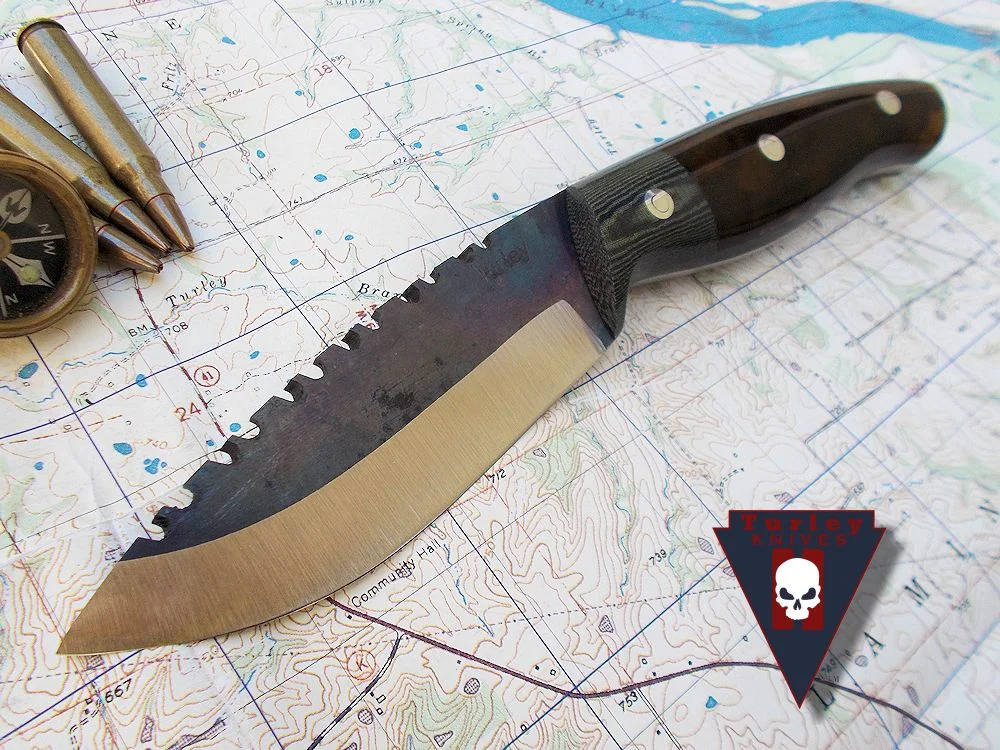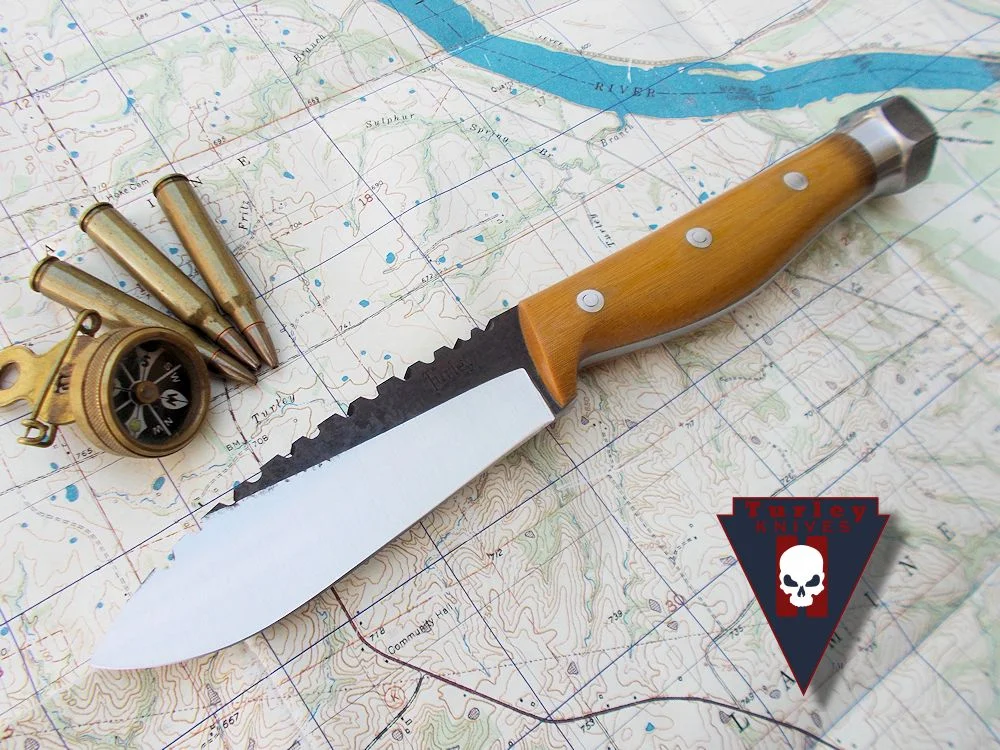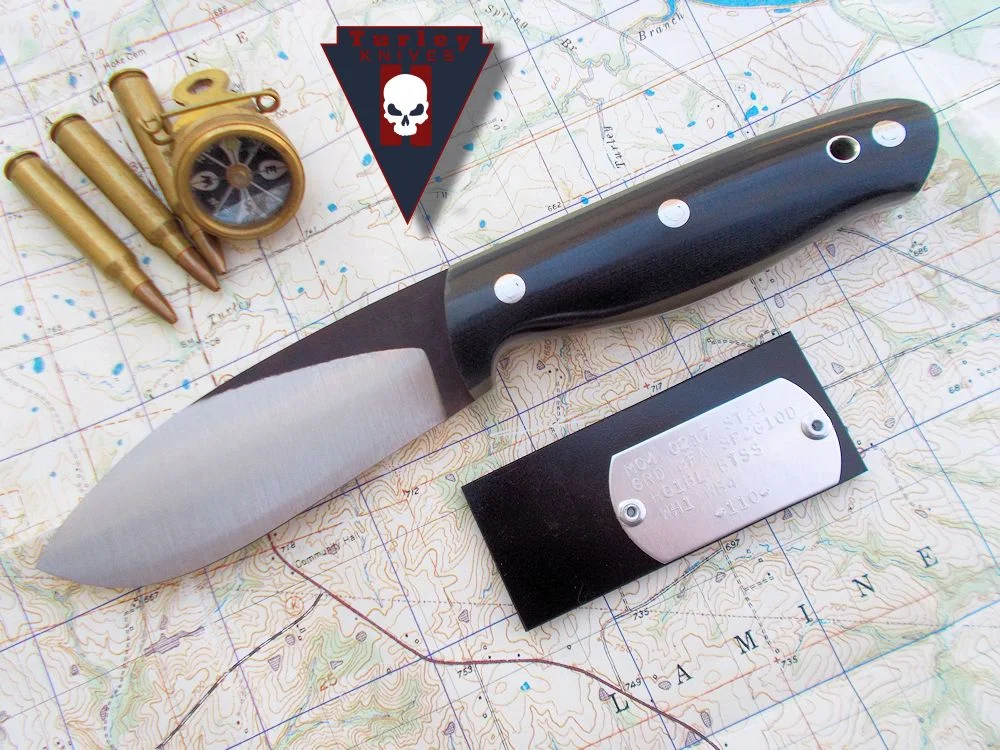Grind information and options
All of my grinds are "flat convex"(except for the “old school full height grind). That is confusing I know, but I don't know another way to describe it. They are convex but nearly flat. They don't have the clunky thickness that convex grinds can have but aren't completely flat so as to retain toughness. All knives come with a small secondary grind at the edge (except for the Old School grind), again for toughness.
Half height grind
Advantages: This grind has more strength (especially at the tip, depending on blade profile and blade thickness) than a full height grind. It's a great grind for those of you who want a tough, nearly indestructible, knife.
Disadvantages: It's a middle ground sort of grind. It does all things moderately well but doesn't stand out at any one task. I believe it's the toughest of the practical grinds and that's it's best asset. "Practical" meaning useful as a knife unlike most 1/4 height grinds.
Varied grind
This grind idea came from how Randall knives grind their Model 6 and a few others. I saw that it displayed great characteristics for people who are used to using Scandi grinds while working with wood. After using only a scandi grind (a 1/4 height grind), people sometimes have trouble using the better slicing grinds, like full height grinds, because of the vast difference from a Scandi grind. Scandi users like the steep bevel of that grind because it makes shaving wood much easier, the bevel sort of sets itself against the wood and keeps the shavings fairly consistent without much work by the user. But the scandi grind is a terrible slicer, even in thinner stock. To get decent slicing ability from one you have to have extremely thin stock which then compromises strength.
The Varied grind solves that problem, by having a lower height grind just in front of the handle (similar to a scandi grind) and progressing to a good slicing, full height near the tip (like a true full height grind). So it's a mixture of both grinds and the best of both worlds. It's a good compromise grind for those who have never used or don't use a full height grind well and are used to the steep bevel of a scandi.
Not available on knives under 5/32" thick.
High Varied grind
This is a half step so to speak, a grind height between the varied grind and full height grind. It gives you a little more slicing ability but with that comes a slightly weaker tip. The grind is really mostly for looks, for those who like a full height grind but don't like the look of it because it shows no grind lines. Only available on 5/32" and thicker stock.
Full height
Advantages: This grind is an amazing slicer. The best choice for a skinning/gutting knife by far. The full height grind is, in most cases, what I consider the best possible grind for an all around knife. It is the best possible grind for functional saw teeth also. The edge is strong enough for any woods work including batoning.
Disadvantages: Depending on the profile you choose, a full height grind can have a weak tip. That weakness gets greater when you choose thinner stock. But with a little common sense when drilling or stabbing into wood and not using the tip to pry will keep it where it's supposed to be, on the knife. After years of using a full height grind in the woods I can honestly say that's the only weakness I know of.
The Old School full height grind: This very much like the full height grind with a couple of very important exceptions. 1: It is a true, full convex grind. There is no flatness to it. It has a smooth arc from edge to the spine. 2: It has no secondary edge. It is a true “zero grind”, meaning the grind runs in a continuous arc from the spine down to a zero edge. The advantages of this grind can’t be overstated. It is by far the best grind for edge toughness and slicing ability you can get. If you want a scary sharp slicer and an amazingly tough knife, this is the best grind in the world. That’s no exaggeration, I’ve used scores of knives for scores of hours in the woods and this is the grind I would choose over any other. There’s no picture here because it looks exactly like a regular full height to the untrained eye.
Reverse Varied grind
Advantages: The idea of this grind is that, for large chipping knives, it gives you lots of strength toward the tip where the chopping sweet spot is located. The part of the edge near the handle rarely gets used with large chopping knives and this grind changes that. With the near full height grind in this spot, near the front of the scales, just forward of the hand, it is possible to use it for finer work like shaving feathers for fire making or for using to carve a notch in a bow drill hearth. This grind makes a large knife twice as useful without sacrificing chopping ability and toughness.
Disadvantages: None that really matter a whole lot. If the grind is too low in front it won't have the extreme bite that a higher grind would have. I try to get the grind out on the sweet spot as high as I can though, it's all dictated by the pattern and thickness of the knife.
Not available on thicknesses less than 5/32"
Commando grind
Advantages: Commando grind means that the spine of the knife is also ground, like the edge. The top edge is usually sharp but if the laws where you live prohibit that, I can leave it dull while still getting the Commando look. What's it good for? Combat and self defense. You have two edges to defend yourself with instead of one, plus it has excellent penetrating ability with such a sharp tip.
Disadvantages: It's not good at much of anything else but combat. It can be used for other things, it just doesn't excel at anything other than what it's made to do.
Not available on thicknesses less than 5/32"





